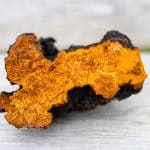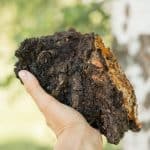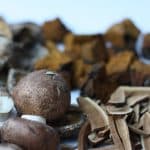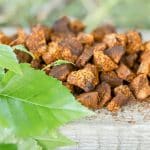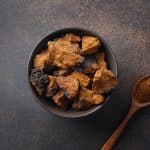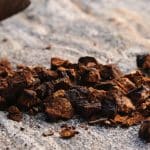Of all functional mushroom species, the best performing one is the inonotus or Chaga, which has an anti-oxidant profile. In fact, it is pretty close to the top of all the antioxidant foods.
Antioxidants are chemicals found in coffee, tea, fruits, vegetables, spices, and mushrooms. They help to protect our cells against oxidative stress.
Eating a diet full of colorful foods and having a healthy chaga dosage, mixed with aromatic herbs and spices is a great way to reap the benefits of antioxidants. Chaga, a black, burned-charcoal-looking mushroom, does not exactly fit this profile, but in its whole-food, powdered form, it provides a simple way to boost your diet with potent antioxidant power. Check out these FAQs to learn about chaga’s benefits, and find out how to integrate optimal doses of chaga mushrooms into your day.
What is the best chaga mushroom dosage?
A daily dosage of 2,000 mg (2 grams) or approximately a teaspoon of a whole-food powdered mushroom that has 20% beta-glucan provides 400 mg of immune-supporting polysaccharides. This amount is enough to trigger host-mediated immune responses, which helps enhance and balance immune functions.
Due to chaga’s high oxalate content, people suffering from gout or kidney stones should check with their physician before using.
How to incorporate chaga into my daily routine?
You can easily incorporate a whole foods chaga into your routine with certified, organic mushroom supplements, powders, drink mixes, and broths. As an alternative, capsules of powdered chaga mushrooms offer a fast, easy way to include this superfood.
You can find our favorite capsules, powders, and tincture’s on the following pages of our website and learn more about each individually:
Best Chaga Mushroom Supplement
How long will it take to see results?
If you are a chaga novice, it may take around three weeks of daily use before your benefits are established. You might want to initially double the recommended 2000mg dosage for the first several weeks, before you settle on a consistent, single dose per day.
What is Oxidative Stress?
As we go about our day, millions of cells in our bodies are performing essential cell functions. As a result, byproducts called free radicals are produced. These molecules, which do not have the full complement of electrons, are also called oxidants, since they can oxidize other molecules by taking away their electrons.
This can damage major cell structures, including membranes, proteins, lipids, and DNA. Free radicals are generated by internal body processes including exercise, stress, and cell aging. They are also caused by external factors, such as environmental toxins, smoking, alcohol, and eating smoked meat.
When kept in a balance of lower concentrations, free radicals are beneficial as messengers inside and among cells. When their concentrations rise, they cause oxidative stress. This causes a domino effect of molecular damage, because oxidants take electrons away from other molecules. According to studies, antioxidants are capable of giving electrons to free radicals, thereby keeping them from damaging cells and tissues in the body.
Ensuring your diet contains plenty of antioxidants is a proactive way of preventing the types of damage that causes chronic diseases and promotes premature ageing. Adding an optimal dose of chaga mushrooms to your routine puts potent antioxidants to work for you.
What Else Should I Know About Chaga?
With wild chaga growing on Birch trees in colder parts of the Northern Hemisphere, it is fairly well known in certain parts of the world. Many cultures revere the medicinal properties of chaga, using it as a functional tea. If you are unfamiliar with this superfood, consider the answers to these commonly asked questions.
Additional Resources:
Can chaga mushroom cure cancer?
Updated 10/24/2022







